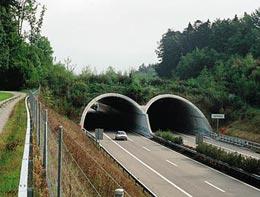Published online 23 February 2009 | Nature | doi:10.1038/news.2009.114
Are bridges over busy roads helping wildlife to breed?
 Wildlife overpasses — help or hindrance?FHWA - Scott Jackson
Wildlife overpasses — help or hindrance?FHWA - Scott JacksonThere is little evidence that the bridges built to allow wildlife to cross roads are helping them to thrive, a review suggests. The study by researchers in Austria points to a lack of genetic studies investigating whether groups of animals on either side of a bridge are breeding with each other.
Animals living in the wild are often reluctant to cross roads to mingle with other populations because of the threat posed by traffic1. They can as a result breed amongst themselves which may lower the genetic diversity of the population over time and make the species more vulnerable to sickness or predators — priming it for extinction.
Roads are known to have stopped inter-population breeding in many animals, from moor frogs (Rana arvalis) and desert tortoises (Gopherus agassizii) to mammals as small as the bank vole (Myodes glareolus) and as large as the black bear (Ursus americanus).
Overpasses, first thought up in the 1960s, are bridges swathed in grass, bushes and trees that are built between two areas of wilderness to help species mingle. Stretches of road near the crossings are fenced off so that wildlife can cross only via the bridge.
Evidence gap
In France, where 125 overpasses have been built, evidence of overpass use has been found in the form of tracks left by roe deer, wild boar (Sus scrofa), red fox (Vulpes vulpes) and numerous other mammals2. In Sweden, moose (Alces alces) and roe deer were found to use an overpass, mostly during the night, and this use declined as traffic volume rose3.
Curious about how much mingling overpasses actually allow, Luca Corlatti and his colleagues at the Institute of Wildlife Biology and Game Management in Vienna set about analysing data from past studies on wildlife overpasses.
Despite finding reports that animals use the overpasses, Corlatti and his team found no studies that compared population genetics before and after the construction of an overpass. They report their findings in Conservation Biology4.
"I am not surprised that the data aren't there," says ecologist Theodore Fleming at the University of Miami in Florida. Historically, Fleming says, studies have placed a much stronger emphasis on demographic processes, probably because wildlife population biologists are not generally trained in population-genetics techniques. And the complexity and cost of combining genetic analysis with demographic work is likely to affect a researcher's chances of obtaining outside funding — even if the person has expertise in both disciplines, he explains.
"I ran into this problem more than 30 years ago with the US National Science Foundation. The foundation was willing to fund my tropical mammal demographic studies but not concurrent genetic studies," Fleming adds.
Another problem, according to Corlatti, is the time needed to investigate the genetic structure of populations separated by a highway before and after an overpass has been constructed. It would take "around 10 years to see whether the bridge is working", he says.
Bridge or barrier?
Generating an idea of the success an overpass is a complicated matter. Without overpasses, wildlife get hit by cars more often, but the fences that come with them may prevent animals that are less afraid of roads from crossing.
"If say, 20 wolves move across an overpass and 100 wolves would have moved across if the overpass was not there in the first place, is that better for the population? What if the 100 wolves experience 5% mortality due to car strikes?" asks road ecologist Shelley Alexander at the University of Calgary in Canada.
ADVERTISEMENT
In unpublished studies, Alexander has found that movement rates "were actually far lower" on sections of highways that had fencing and crossings than on the highest-volume roads in Banff National Park in Canada. But, she adds, "there is no doubt in my mind that overpasses are doing a lot of good, especially in areas of high traffic flow".
Parks Canada says that its unpublished research suggests the bridges are working. Although Corlatti and his colleagues work may have taken into account most the published literature, says Cliff White, Environmental Sciences Coordinator at the Banff Field Unit, "recent and ongoing research [within Banff] indicates that wildlife overpasses may be very successful in providing opportunities for genetic exchange by many wildlife species". Hundreds of individually marked hoofed mammals have made "tens of thousands of crossings of highway wildlife crossing structures. This is almost a trivial topic for genetic research", he says.
References
- Mata, C., Hervás, I., Herranz, J., Suárez, F. & Malo, J. E. Biol. Conserv. 124, 397–405 (2005). | Article |
- Van Wieren, S. E. & Worm, P. B. Netherlands J. Zool. 51, 97–105 (2001). | Article |
- Olsson, M. P. O., Widén, P. & Larkin, J. L. Landsc. Urban Plan. 85, 133–139 (2008). | Article |
- Corlatti, L., Hackländer, K. & Frey-Roos, F. Conserv. Biol. doi:10.1111/j.1523-1739.2008.01162.x (2009).



Nenhum comentário:
Postar um comentário